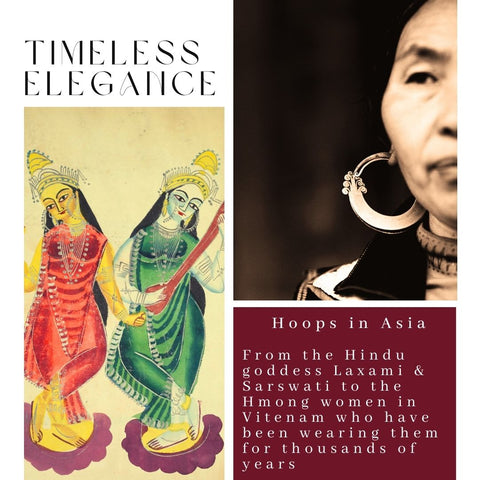An ever-popular genderless accessory, hoop earrings have been worn by many key figures in history. From Hindu Gods and Goddesses to Caesar, from Persian princes, Egyptian pharaohs and queens, to sailors, slaves, dancers, and even cats – hoops have been worn throughout the ages.
Hoops may be trending, but this trend has been around for a very long time. The oldest earrings discovered so far, crescent shaped gold hoops, belonged to a Sumerian woman who lived in Mesopotamia (present day Iraq) in 2500 BC.

In these earliest days of hoop-wearing, Sumerian men and women flaunted hoops on their ears. They believed earrings enhanced beauty, their circles representing unity, infinity, and perfection. As a circular fashion brand with a penchant for hoops, we at DEZEN are just as fascinated with this timeless shape.
Hoops – of course – didn’t stop with the Sumerians. You can see them worn by Egyptian dancers in ancient art (in our favorite example, by a young girl doing acrobatics), and they’re also found in Minoan fresco paintings from Greece.
In Egypt, Pharaohs like Nefertiti, Hatshepsut, Tutankhamen, and Cleopatra wore hoop earrings to display their status, power and wealth.
Even with so much history behind them, hoops remain beautiful and stylish enough to wear today.
Earrings haven’t always just been a fashion statement. In parts of Europe, doctors believed they cured headaches and could improve eyesight.
Sailors wore hoop earrings to signify they had traveled around the world – it was a non-verbal bragging signal. Other sailors used their hoops as an insurance policy. If they died at sea, the gold hoops could be sold and the money used to pay for a proper burial, even hundreds of miles from home.
Hoop earrings have a deep history in Asia, too. The Hmong women in Vietnam have been wearing them for thousands of years, and continue to wear them today as part of their cultural heritage. Their hoop earrings are often made of silver and have the sun and moon carved into them, representing the gods of power. The size of the hoop depicts strength, health, and how hard working the woman is – the bigger the better.
Many Hindu gods and goddesses are adorned with hoop earrings. It is said that the earring on the left ear of Lord Shiva represents women and the one on the right represents men and that together they represent the balance of male and female energy also referred to as Shiv and Shakti.

In Western society, however, hoops have been more controversial. At one point the church even banned them. In the early 1900’s, ear piercings carried a negative stigma through their association with Native American and Latin cultures considered barbaric.
They made a resurgence in the 1920s and 30s as Spanish and Egyptian styles became fashionable (there’s nothing as fickle as fashion!). With the discovery of King Tutankhamen’s tomb in Egypt, ancient traditions were all the rage. Women commonly wore hoops with a short bob haircut. Josephine Baker, an American entertainer, was often seen wearing gold hoops on stage.
During the 60s and 70s, women straightened their hair and wore hoop earrings as a sign of female power. The hoop designs were influenced by both the African American and Latina communities, as well as styles from India and the Near East. During this period the hoop earrings were symbolic of the feminist movement and the accessory of choice to make a statement.
Iconic singers like Diana Ross and Jennifer Lopez have been wearing this timeless accessory to showcase independence, individuality, and creativity for decades. But these traits aren’t just for entertainers.
Sonia Sotomayor, a Supreme Court Justice appointed by Barack Obama in 2009, was advised not to wear her signature red nail polish and hoops for her swearing in ceremony, but she stuck to her style and wore them.

This inspired Alexandria Ocasio-Cortez, the youngest ever Congresswoman, to also choose hoops for her oath ceremony in 2019. Later she addressed the look in a powerful tweet:
“Next time someone tells Bronx girls to take off their hoops, they can just say they’re dressing like a Congresswoman.”
With all of this history behind them, you could say that hoop earrings aren’t trending – they never went away. Today they symbolize independence, resilience, and empowerment, and hold deep, historic meanings for a wealth of communities.
As both a circular and digital fashion accessories company, DEZEN launched the Desert Mesa Hoop earrings as our first product – representing our commitment to circular principals, an ode to the planet, a style that looks beautiful on everyone. Hoop earrings are a centuries old accessory seen all over the world, worn by men and women, conveying not only fashion but strength – which is why they will always be in fashion.




Leave a comment